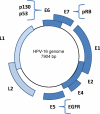Biology of human papillomavirus infection and immune therapy for HPV-related head and neck cancers
- PMID: 22793854
- PMCID: PMC3398423
- DOI: 10.1016/j.otc.2012.04.005
Biology of human papillomavirus infection and immune therapy for HPV-related head and neck cancers
Abstract
This article outlines the biology of human papillomavirus (HPV) infection of human mucosa and the cellular pathways that are altered through viral infection. The article provides a conceptual framework with which to understand the 2 major immunologic strategies to address HPV-related diseases: (1) prevention of primary HPV infection through the use of prophylactic vaccines and (2) treatment of established infection and diseases through therapeutic vaccines. Nonimmunologic therapy that targets cellular dysregulation induced by HPV infection is also discussed. The challenges in actualizing these conceptually attractive therapies on both a societal and biological level are examined.
Copyright © 2012 Elsevier Inc. All rights reserved.
Figures



Similar articles
-
Manifestations of Human Papillomavirus in the Head and Neck.Med Clin North Am. 2021 Sep;105(5):849-858. doi: 10.1016/j.mcna.2021.05.007. Med Clin North Am. 2021. PMID: 34391538 Review.
-
Human papillomavirus in cervical cancer and oropharyngeal cancer: One cause, two diseases.Cancer. 2017 Jun 15;123(12):2219-2229. doi: 10.1002/cncr.30588. Epub 2017 Mar 27. Cancer. 2017. PMID: 28346680 Review.
-
Regulation of immune responses to HPV infection and during HPV-directed immunotherapy.Immunol Rev. 2011 Jan;239(1):85-98. doi: 10.1111/j.1600-065X.2010.00966.x. Immunol Rev. 2011. PMID: 21198666 Review.
-
The current state of therapeutic and T cell-based vaccines against human papillomaviruses.Virus Res. 2017 Mar 2;231:148-165. doi: 10.1016/j.virusres.2016.12.002. Epub 2016 Dec 6. Virus Res. 2017. PMID: 27932207 Free PMC article. Review.
-
Perspectives for the development of human papillomavirus vaccines and immunotherapy.Expert Rev Vaccines. 2010 Jan;9(1):35-44. doi: 10.1586/erv.09.145. Expert Rev Vaccines. 2010. PMID: 20021304 Review.
Cited by
-
Association of serum cytokines with oral HPV clearance.Cytokine. 2016 Jul;83:85-91. doi: 10.1016/j.cyto.2016.04.002. Epub 2016 Apr 8. Cytokine. 2016. PMID: 27064455 Free PMC article. Clinical Trial.
-
Human immunodeficiency virus is a driven factor of human papilloma virus among women: evidence from a cross-sectional analysis in Yaoundé, Cameroon.Virol J. 2020 May 19;17(1):69. doi: 10.1186/s12985-020-01340-y. Virol J. 2020. PMID: 32430034 Free PMC article.
-
Regression of human papillomavirus intraepithelial lesions is induced by MVA E2 therapeutic vaccine.Hum Gene Ther. 2014 Dec;25(12):1035-49. doi: 10.1089/hum.2014.024. Hum Gene Ther. 2014. PMID: 25275724 Free PMC article. Clinical Trial.
-
Gene Expression Profiling of MicroRNAs in HPV-Induced Warts and Normal Skin.Biomolecules. 2019 Nov 21;9(12):757. doi: 10.3390/biom9120757. Biomolecules. 2019. PMID: 31766385 Free PMC article.
-
HPV16 Impacts NHERF2 Expression in Oropharyngeal Cancers.Pathogens. 2023 Aug 3;12(8):1013. doi: 10.3390/pathogens12081013. Pathogens. 2023. PMID: 37623973 Free PMC article.
References
-
- Dunne EF, et al. Prevalence of HPV infection among females in the United States. JAMA. 2007;297(8):813–9. - PubMed
-
- Castle PE, et al. A prospective study of age trends in cervical human papillomavirus acquisition and persistence in Guanacaste, Costa Rica. J Infect Dis. 2005;191(11):1808–16. - PubMed
-
- Munoz N, et al. Incidence, duration, and determinants of cervical human papillomavirus infection in a cohort of Colombian women with normal cytological results. J Infect Dis. 2004;190(12):2077–87. - PubMed
Publication types
MeSH terms
Substances
Grants and funding
LinkOut - more resources
Full Text Sources
Other Literature Sources
Medical
Molecular Biology Databases

